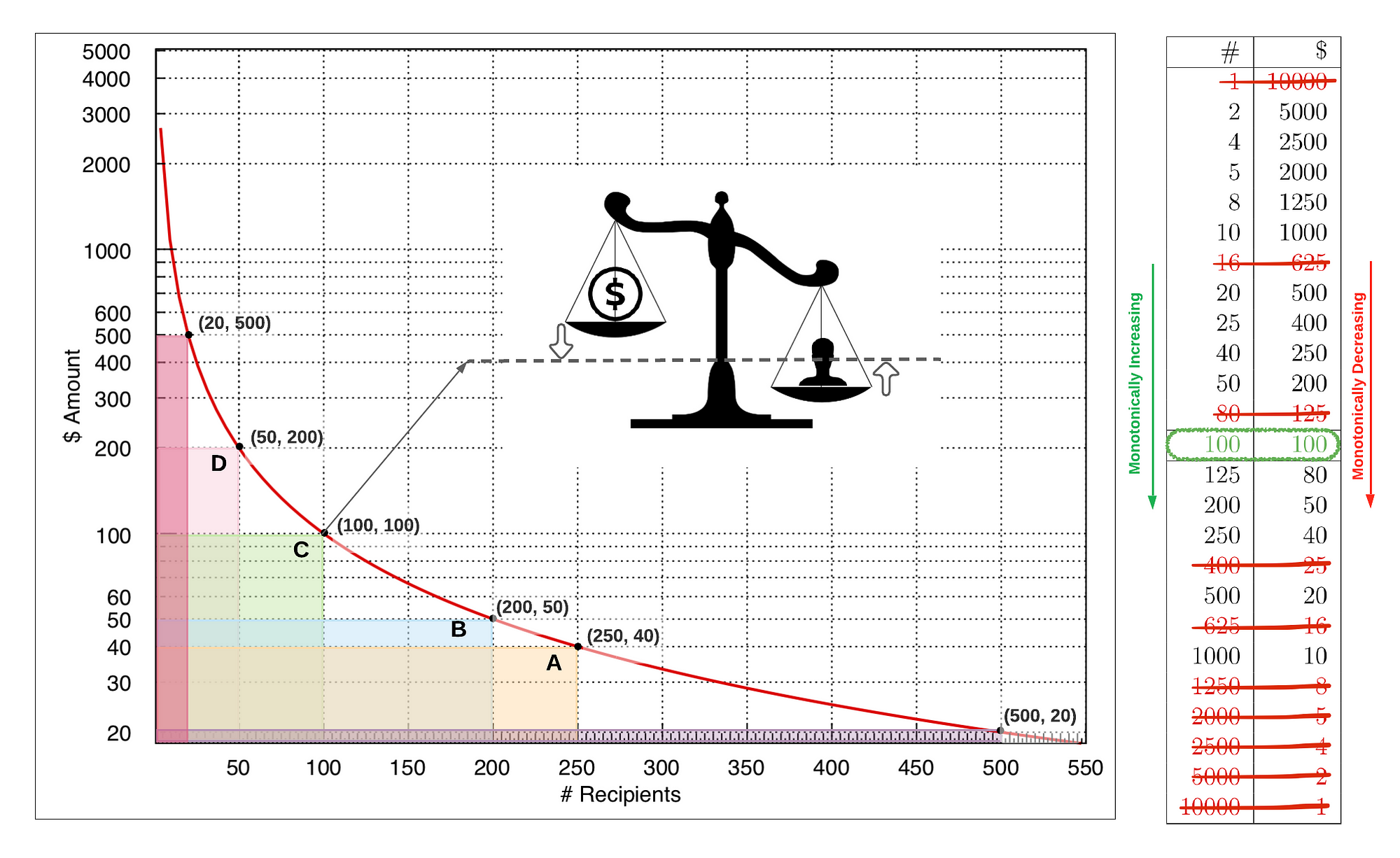Radically Utilitarian
Developing an Intuition for Radicals

The word radical is overloaded in the vernacular probably because it is important. Catchy as the title may appear, our concern is math radicals! Pun aside, they are a mathematical construct — a product of the human mind. Their serendipitous emergence in natural laws is a curious fact. Is that coincidence?
It can’t be. Unlike the appearance of faces in clouds, they track reality and hold predictive power. They appear in diverse pursuits of inquiry such as Physics, Engineering, Economics, Game Theory, Biology, and Political Science. Is there a unifying theme that underlies their emergence?
In a series of posts, I want to explore concepts involving radicals. With examples and visual aids, let’s first develop an intuition for them. We will see how they can naturally emerge in subsequent posts.
Squaring Away Intuitions
Radical Departure
Mother nature’s machinations are a radical departure from everyday experience. Every so often, we get lucky and stumble upon her innards. Upon interrogation, what we discover never ceases to surprise us. An alien, albeit amazing reality lurks that flies in the face of commonly held intuitions.
It’s hard to wrap our heads around inverse square (or square root) laws, power laws, scaling laws, or the laws of extremes — the ultra-fast, the ultra-small, or the astronomically large. We don’t feel them in our bones. How thick is a newspaper repeatedly folded twenty times? If earth were a gumball, how big is a globe that holds a million gumballs? Hard as they seem, we must try and intuit.
Mathematics
Our discoveries are most often couched in the language of mathematics — a magnificent gift to humankind. I often wonder how hominids with outsized brains could stumble upon symbols and noises that map onto reality, prove useful like the device you are staring at. We’d like to believe discovering mathematics (and logic) wasn’t inevitable along our evolutionary course. It endures, despite our fallible intuitions. It helps us navigate across the great void of the unknown.
Most readers are acquainted with radicals. If not, Radical Expressions has a gentle introduction. Let’s begin by solving a problem, and in due course, develop a basic intuition.
Utilitarian
A certain Ms. Glitzy Glamour has ten yellow-strap bundles lying around in her closet. Having pondered society’s ills on a Wednesday night, she turns into a utilitarian and has decided to part with her largess.
Question: How should she share her riches so that a maximum number of recipients each receive a maximum dollar amount?
In other words, how can we maximize the utility? Ethical and moral quandaries aside, satisfying her heart’s desire reduces to a distribution (partitioning) problem. The most a single recipient can get is $10K if they get all of it. The least anyone can get is $10 (a single bill) should a thousand share. Both extremes violate the intuition of doing maximum good. Is there a median-magic-pair of (beneficiaries, dollar-amount) that can maximize both? It gets easier if we recast the problem in geometry — let’s play a groovy game.
A Groovy Game
Let’s denote the pair (persons, dollar-amount) by (#,$). Start by finding the total amount. A yellow-strap has 100 notes per bundle.
Total = ($10)·(100/bundle)·(10 bundles) = $10,000

Figure 1. shows a red groovy path. A ball is constrained to move within. Several indentations (black dimples) lie along the groove like pit-stops for the ball to rest. Few key ordered pairs (A, B, C, D) are placed strategically at the top-right corners of rectangles (A=orange, B=blue, C=green, D=pink). The rectangles kiss the curve and are resting against two orthogonal axes ($ Amount vs. # Recipients). For convenience, the vertical axis is drawn to a logarithmic scale and the horizontal to linear. The table beside it lists all pairs which we will deal with later. But first, let’s focus on the inset — a cartoon with an old-fashioned scale.
Heavy On Her Mind
Figuratively, let’s place all one-thousand $10 bills on one side (dollar-plate) and nothing on the other (recipient-plate). The scale is out-of-balance. And that must be weighing heavily on Ms. Glamour’s mind.
- Let’s lighten the load, again by figuratively placing two recipients on the recipient-plate. In this case, each person pockets $5000 for the scale’s return to balance. We cannot place three recipients (because 10 isn’t a multiple of 3 and we can’t slice the $10-bill). How about four? Yes, we can and each gets $2500. Five? Yes. And so on we proceed to balance the scale and adding recipients. What we are in effect doing is factorizing 10K each time our answer is yes! And we continue tipping the scale as the dollar-plate is getting lighter and the recipient-plate is getting heavier.
- For Glitzy’s sake, we keep adding new recipients until we reach a thousand each getting only $10 and stop. The scale tipped over completely to the other side! We must have blown past the tipping point along the way.
- Now we reverse our strategy and start kicking out individuals from the recipient-plate, this time knowing when to stop. We stop when it’s “just right” — in the Goldilocks zone as it were. This sweet spot is special. Let’s find out why.
Claim: The sweet spot is the square root of 10000.
Q&A Along The Weigh
Q: What does the groovy curve represent?
A: The infinity of solutions. But only some satisfy this problem’s constraints.
- What is this constraint? No matter the number of individuals and their corresponding dollar amounts, their product remains constant and must equal 10K — the total amount Glitzy has decided to part with. One person keeps $10K, two share $5K, ten sharing $1K, etc.
$ · # = 10000 OR y · x = 10000 ··· (1)
- The equation of the groove is a rectangular hyperbola! Given its discrete nature, we must restrict our solution only to certain positive integers. Notice their product is 10K by construction. Some are shown below.
A = (250, 40) B = (200, 50)
C = (100, 100) D = (50, 200) ··· (2)
Q: How many ordered pairs fit the pattern?
A: 25
- Start by finding its prime factors.
10000 = 10⁴ = (2·5)⁴ = 2⁴·5⁴ ··· (3)
- To find the number of factors (N), increment their indices and take their product, i.e., N = (4+1)·(4+1) = 25. We can proceed and list all combinations as shown below.
Factors = {1}, {2,2²,2³,2⁴},
{5,5²,5³,5⁴},
{2·5,2²·5,2³·5,2⁴·5},
{2·5²,2·5³,2·5⁴},
{2²·5²,2³·5²,2⁴·5²},
{2²·5³,2²·5⁴},
{2³·5³,2⁴·5³},
{2³·5⁴},{2⁴·5⁴} = {1},{2,4,8,16},
{5,25,125,625},
{10,20,40,80},
{50,250,1250},
{100,200,400},
{500,2500},
{1000,2000},
{5000},
{10000}
Q: Is there a median-magic-pair? And if so, what is it?
A: Yes, (100, 100)
- We can pick each factor (x) and its counterpart, 10000/x (see adjacent table) as a pair. Going top-to-bottom, the number of recipients (#) monotonically increases (green arrow) as the dollar amount monotonically decreases (red arrow). Notice they briefly settle for a truce at the inflection point (100, 100) before diverging. Figure 2 captures this idea in a cartoon. Of all the pairs (indicated by moving arrow) there is one pair (100, 100) that maximizes both.

When we eliminate the extreme-pairs and those with dollar amounts that are not multiples of ten, what’s left may entail the magic-median-pair.
Intuition
The intuition here is to greedily stretch the dollar amount and recipients simultaneously along orthogonal axes until we can no longer do so. They oppose each other because of the constraint. As the yin and yang dance occurs between the two extremes, we arrive at an intermediate partition of one hundred recipients pocketing $100 each. Looking at the table, we are convinced that’s the best we can do and stop. This is just the pair we have been after. Ms. Glamour’s heart is now maximally content!
Fair And Square
If we jot down 10000 = $100 x 100 (recipients) and stare at it for a moment and realize you could have just found its square root!
√10000 = √(100 · 100) = 100 ····· (2)
But where is the fun in that? The square root is precisely that which maximizes the utility for this problem. For two variables (#) and ($) that are constrained only by the total area, finding the square root is akin to picking many possible rectangles with area = 10K for inspection (A, B, D, etc.), but settling on just one square formed by the median-magic-pair! The green area, denoted by C = (100, 100) would be the final answer!
A square is the only rectangle that stretches both length and width maximally for a given area.
If you had three independent variables constrained only by their volume, you could find its cube root that maximized the utility. And a fourth root would maximize the utility in four dimensions etc. But proving is a bit tricky.
Fun Facts
Interesting facts about the square roots emerge from this exercise. Notice how the factors of 10K pivot and fold at 100.
# = {1, 2, 4, … , 100, …, 2500, 5000, 10000}
$ = {10000, 5000, 2500,… , 100, …, 4, 2, 1}
Paying close attention divisor pairs { (2,5000) (4, 2500), …} we notice they are on either side of the pivot point (100).
- When searching for divisors of 10K we can stop as soon as we reach the half-way mark at 100 (its square-root), saving ourselves some effort. The rest are their counterparts that yield 10K as their product.
5000 = 10K/2, 2500 = 10K/4, …, 125 = 10K/80, 100 = 10K/100
- In a test for primality of integer m, we only need check for prime factors until we reach √m. If we don’t find any, we claim m is a prime number.
Developing an intuition wasn’t hard, was it? I had fun researching and writing this article. Hope you enjoyed reading it.
References
- Consumer Theory in Microeconomics, Khan Academy.
- Utility Function
- Cobb-Douglas Utility Function
- Indifference Curves
©️ Dr. VK, 2021. All Rights Reserved.




